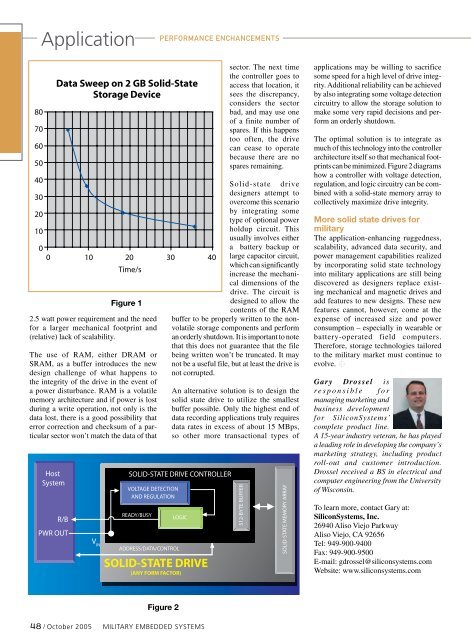Military Embedded Systems - Fall 2005 - Volume 1 Number 2
Military Embedded Systems - Fall 2005 - Volume 1 Number 2
Military Embedded Systems - Fall 2005 - Volume 1 Number 2
You also want an ePaper? Increase the reach of your titles
YUMPU automatically turns print PDFs into web optimized ePapers that Google loves.
Application<br />
Performance enchancements<br />
2.5 watt power requirement and the need<br />
for a larger mechanical footprint and<br />
(relative) lack of scalability.<br />
The use of RAM, either DRAM or<br />
SRAM, as a buffer introduces the new<br />
design challenge of what happens to<br />
the integrity of the drive in the event of<br />
a power disturbance. RAM is a volatile<br />
memory architecture and if power is lost<br />
during a write operation, not only is the<br />
data lost, there is a good possibility that<br />
error correction and checksum of a particular<br />
sector won’t match the data of that<br />
Host<br />
System<br />
Data Sweep on 2 GB Solid-State<br />
Storage Device<br />
R/B<br />
PWR OUT<br />
V IN<br />
Time/s<br />
Figure 1<br />
sector. The next time<br />
the controller goes to<br />
access that location, it<br />
sees the discrepancy,<br />
considers the sector<br />
bad, and may use one<br />
of a finite number of<br />
spares. If this happens<br />
too often, the drive<br />
can cease to operate<br />
because there are no<br />
spares remaining.<br />
Solid-state drive<br />
designers attempt to<br />
overcome this scenario<br />
by integrating some<br />
type of optional power<br />
holdup circuit. This<br />
usually involves either<br />
a battery backup or<br />
large capacitor circuit,<br />
which can significantly<br />
increase the mechanical<br />
dimensions of the<br />
drive. The circuit is<br />
designed to allow the<br />
contents of the RAM<br />
buffer to be properly written to the nonvolatile<br />
storage components and perform<br />
an orderly shutdown. It is important to note<br />
that this does not guarantee that the file<br />
being written won’t be truncated. It may<br />
not be a useful file, but at least the drive is<br />
not corrupted.<br />
An alternative solution is to design the<br />
solid state drive to utilize the smallest<br />
buffer possible. Only the highest end of<br />
data recording applications truly requires<br />
data rates in excess of about 15 MBps,<br />
so other more transactional types of<br />
SOLID-STATE DRIVE CONTROLLER<br />
VOLTAGE DETECTION<br />
AND REGULATION<br />
READY/BUSY<br />
PWR<br />
ADDRESS/DATA/CONTROL<br />
LOGIC<br />
SOLID-STATE DRIVE<br />
(ANY FORM FACTOR)<br />
512-BYTE BUFFER<br />
SOLID-STATE MEMORY ARRAY<br />
applications may be willing to sacrifice<br />
some speed for a high level of drive integrity.<br />
Additional reliability can be achieved<br />
by also integrating some voltage detection<br />
circuitry to allow the storage solution to<br />
make some very rapid decisions and perform<br />
an orderly shutdown.<br />
The optimal solution is to integrate as<br />
much of this technology into the controller<br />
architecture itself so that mechanical footprints<br />
can be minimized. Figure 2 diagrams<br />
how a controller with voltage detection,<br />
regulation, and logic circuitry can be combined<br />
with a solid-state memory array to<br />
collectively maximize drive integrity.<br />
More solid state drives for<br />
military<br />
The application-enhancing ruggedness,<br />
scalability, advanced data security, and<br />
power management capabilities realized<br />
by incorporating solid state technology<br />
into military applications are still being<br />
discovered as designers replace existing<br />
mechanical and magnetic drives and<br />
add features to new designs. These new<br />
features cannot, however, come at the<br />
expense of increased size and power<br />
consumption – especially in wearable or<br />
battery-operated field computers.<br />
Therefore, storage technologies tailored<br />
to the military market must continue to<br />
evolve.<br />
Gary Drossel is<br />
r e s p o n s i b l e f o r<br />
managing marketing and<br />
business development<br />
for Silicon<strong>Systems</strong>’<br />
complete product line.<br />
A 15-year industry veteran, he has played<br />
a leading role in developing the company’s<br />
marketing strategy, including product<br />
roll-out and customer introduction.<br />
Drossel received a BS in electrical and<br />
computer engineering from the University<br />
of Wisconsin.<br />
To learn more, contact Gary at:<br />
Silicon<strong>Systems</strong>, Inc.<br />
26940 Aliso Viejo Parkway<br />
Aliso Viejo, CA 92656<br />
Tel: 949-900-9400<br />
Fax: 949-900-9500<br />
E-mail: gdrossel@siliconsystems.com<br />
Website: www.siliconsystems.com<br />
Figure 2<br />
48 / October <strong>2005</strong> <strong>Military</strong> EMBEDDED SYSTEMS
















